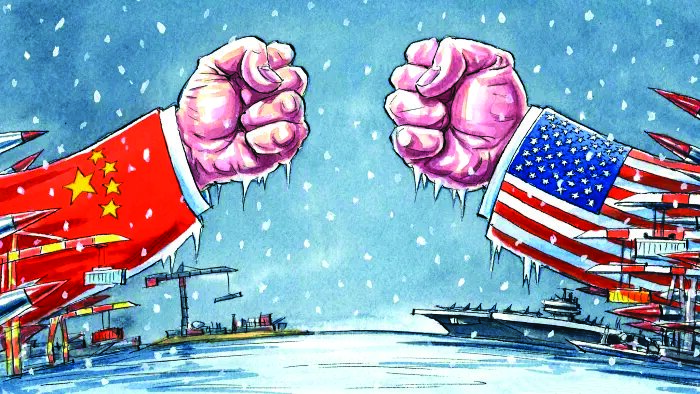Imagine this: two alpha students fighting in the playground, the whole school is distracted, teachers are running around to separate the two, it is a difficult and challenging time for everyone. In the geo-political arena, this is similar to how trade wars work!
What is a trade war? A trade war happens when one country imposes tariffs or quotas on imports from other countries and foreign countries retaliate in a similar way. In policy jargon, this is called protectionism. Prior Op-eds have already established that policy is a galvanizing vision that describes the end goal. However, in this case trade war as one of the strategies executing the policy of protectionism will undermine the one thing that all parties involved are trying to achieve. Bring prosperity and growth to their country! This is because as trade war escalates, it reduces international trade the lynchpin for prosperity and growth!
There have been many trade wars in the past then why the current US-China stand off is different? And why the US may have to back-off in this instance? Consider.
In the past decade China has emerged as one of the foremost counterweights to US hegemony. Since the fall of the Soviet Union, the US was the single and dominant superpower in the world and had enjoyed that status till the manufacturing-driven rise of China. More crucially, it is China’s Belt and Road Initiative (BRI) that is giving the US sleepless nights! And is one of the biggest reasons of ratcheting trade war between the two global players. This project is commonly called ‘one belt, one road’ and is thought of as a 21st century silk route! Confusingly, it is made up of a ‘belt’ of overland corridors and a maritime ‘road’ of shipping lanes and reflects China’s grand ambition for the future global trade dominance! In numbers, this initiative includes almost 71 countries and accounts for a quarter of global GDP and almost half the world’s population. It ranges from South-east Asia to Eastern Europe and Africa encompassing pretty much the whole globe. It is not only about infrastructure as Jonathan Hillman, director of the Reconnecting Asia project, puts it “BRI is about more than roads, railways, and other hard infrastructure, it’s also a vehicle for China to write new rules, establish institutions that reflect Chinese interests, and reshape ‘soft’ infrastructure”. Facing so much challenge to its dominance and seeing that the future may allow China freer access to so many other markets, it is no wonder that the US chose to lock-horns with the Chinese by putting trade tariffs on Chinese imports. Not only that, the US also asked other Western countries to follow suit the need for black-listing Huawei, the Chinese telecom equipment maker, a case in point. In a tit-for-tat, the Chinese also added approximately $100B worth of tariffs on US imports into China. Though, theirs’ was a necessary riposte to the initial action taken by the Trump administration.
Current estimates suggest that a lurch towards protectionism worldwide and further escalation of the trade war between US and China may lead to a permanent loss of 3% of GDP for the US and almost 1% for China. This is not without precedence! The 1930 US Smoot-Hawley Tariff Act raised tariffs on more than 20,000 goods with a reciprocal action from all trading partners. This alone reduced two-thirds of world trade! Considering the globalised world of today, the risks are even greater this time around! The Organization for Economic Co-operation and Development (OECD) also forecasts that there will be a reduction in business investment growth from 3.5% in the last couple of years to 1.75% in the next couple! Even in the US, 25% of goods producers and 30% of manufacturers have reassessed their expenditure and expansion plans owing to the negative sentiment generated by the US-China trade war.
Since the US fired the opening salvo in the trade war two years ago, the standoff did seem to enter a temporary truce when the two countries signed a ‘phase one’ trade deal. Although this deal didn’t change the underlying subtleties drastically but at-least both parties agreed to negotiate further during the next round of trade talks. A good start, nevertheless. Taking into account the new global dynamics, and the fact that the Chinese maybe able to withstand longer periods of such a trade war, it will have to be the US to concede more!
Considering the equilibrium in superpower dynamics, it does seem that the US has chosen poorly to escalate the trade war at the start of the new decade. Hong Kong property developer and chairman of Far East Consortium International, Tan Sri Dato’ David Chiu, said this about the US at the World Economic Forum in Davos. “They should have picked the war 10 years ago. Today, China has 1.4 billion people the world’s second largest economy”. He further asked, “who is going to consume more McDonald’s and Coca-Cola than China?” The US itself has based its growth model on consumerism and it prides itself on the achievement of the American Dream because of it! Thus, it doesn’t make sense at all that it should curtail itself from a potential 1.4 billion consumers because of a naively started trade war! Since the US fired the opening salvo in the trade war two years ago, the standoff did seem to enter a temporary truce when the two countries signed a ‘phase one’ trade deal. Although this deal didn’t change the underlying subtleties drastically but at-least both parties agreed to negotiate further during the next round of trade talks. A good start, nevertheless. Taking into account the new global dynamics, and the fact that the Chinese maybe able to withstand longer periods of such a trade war, it will have to be the US to concede more! After all, the US has done the same thing in the past to other countries. How quickly tables can turn!





